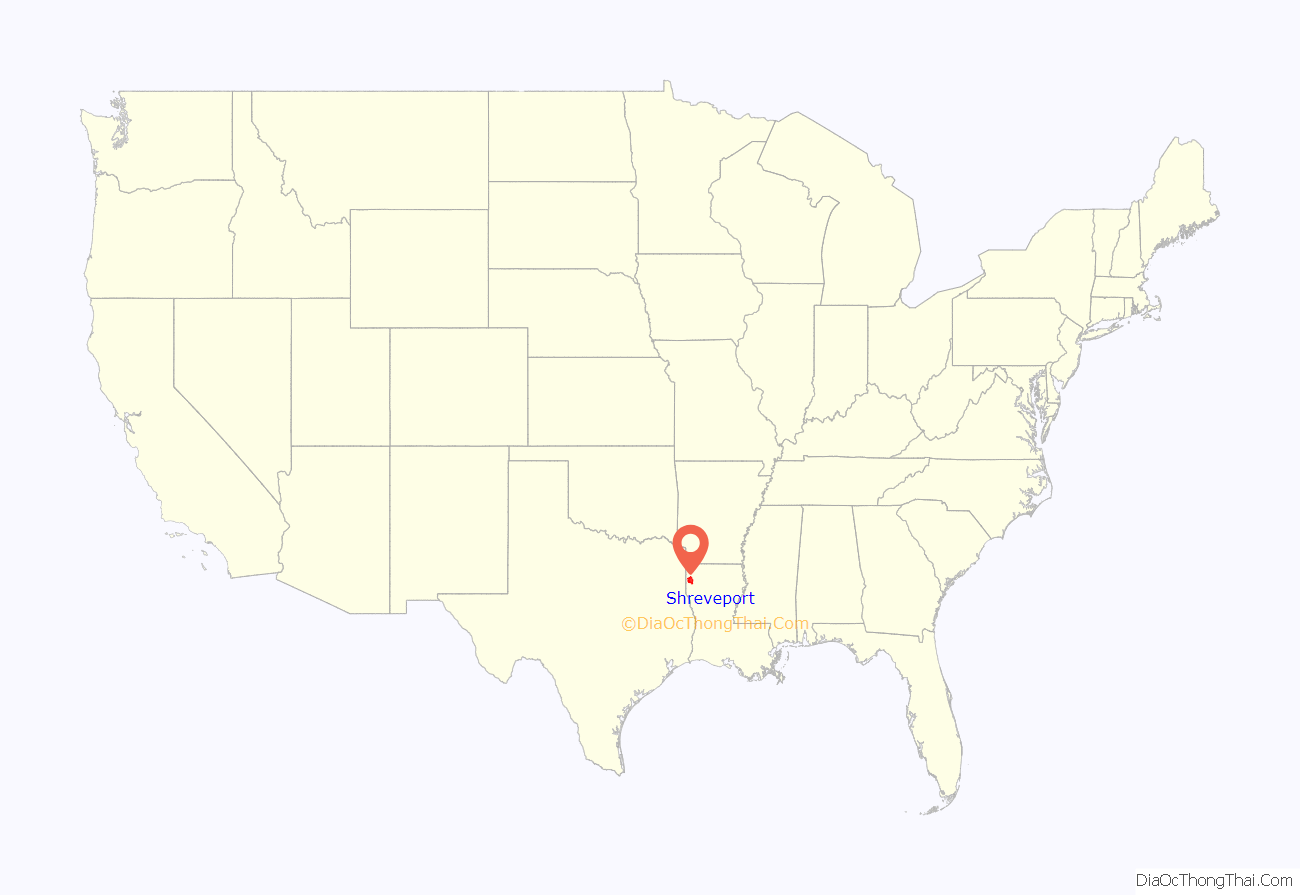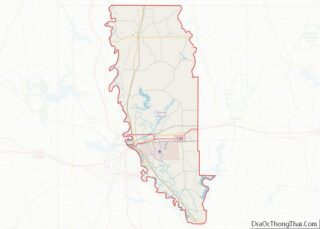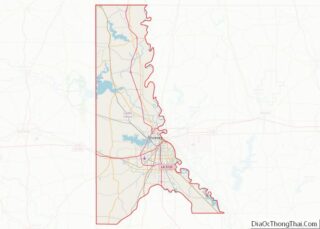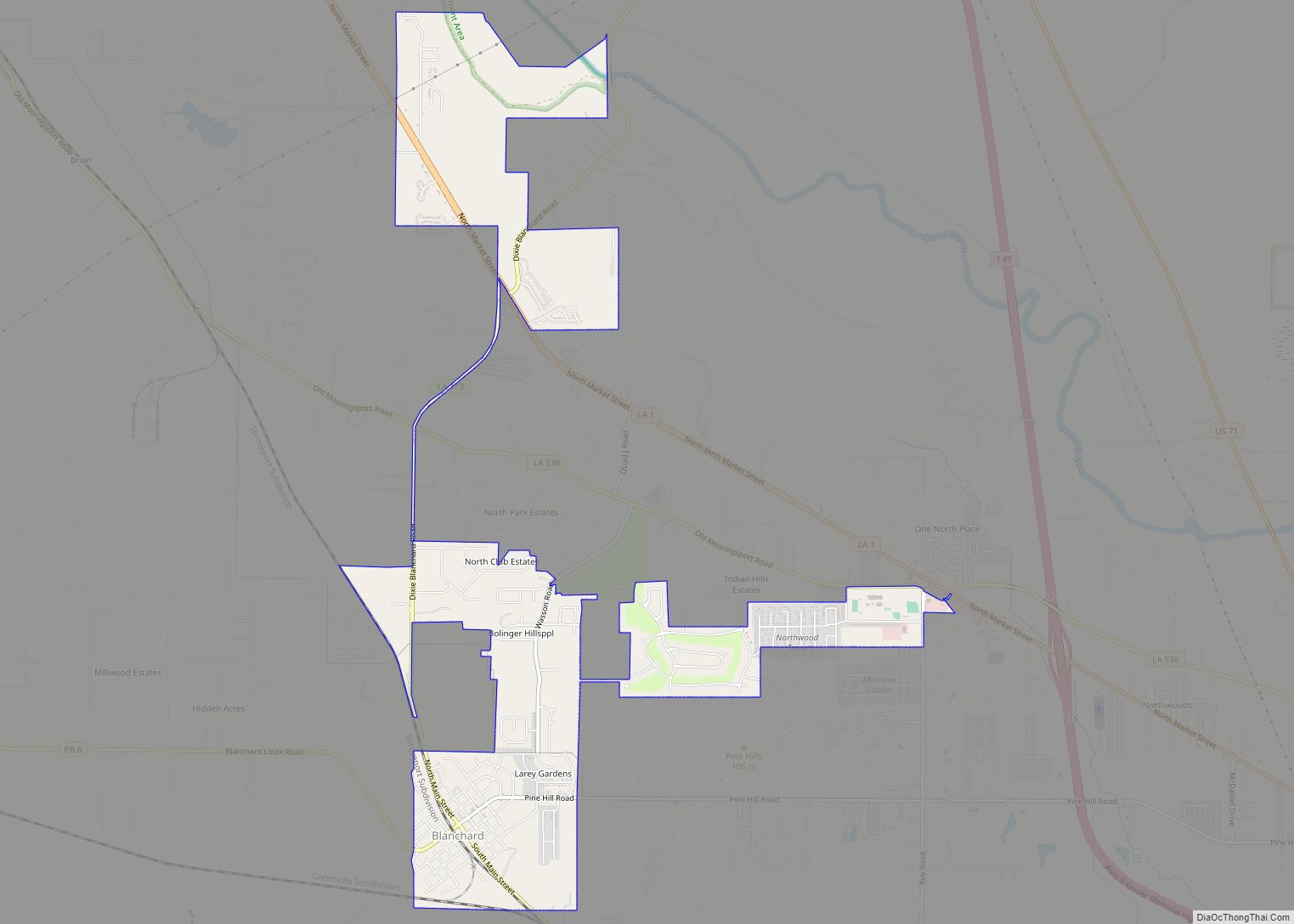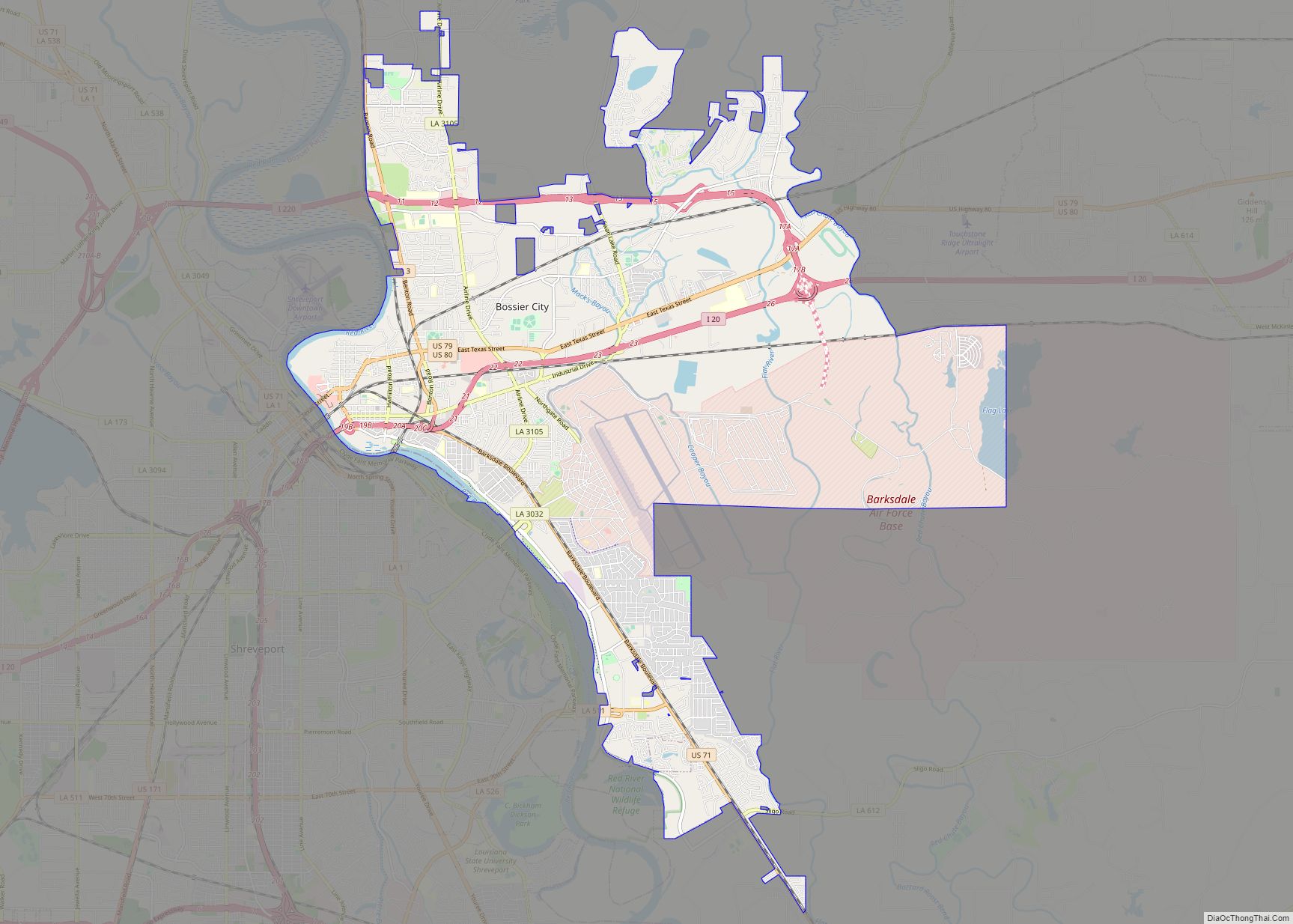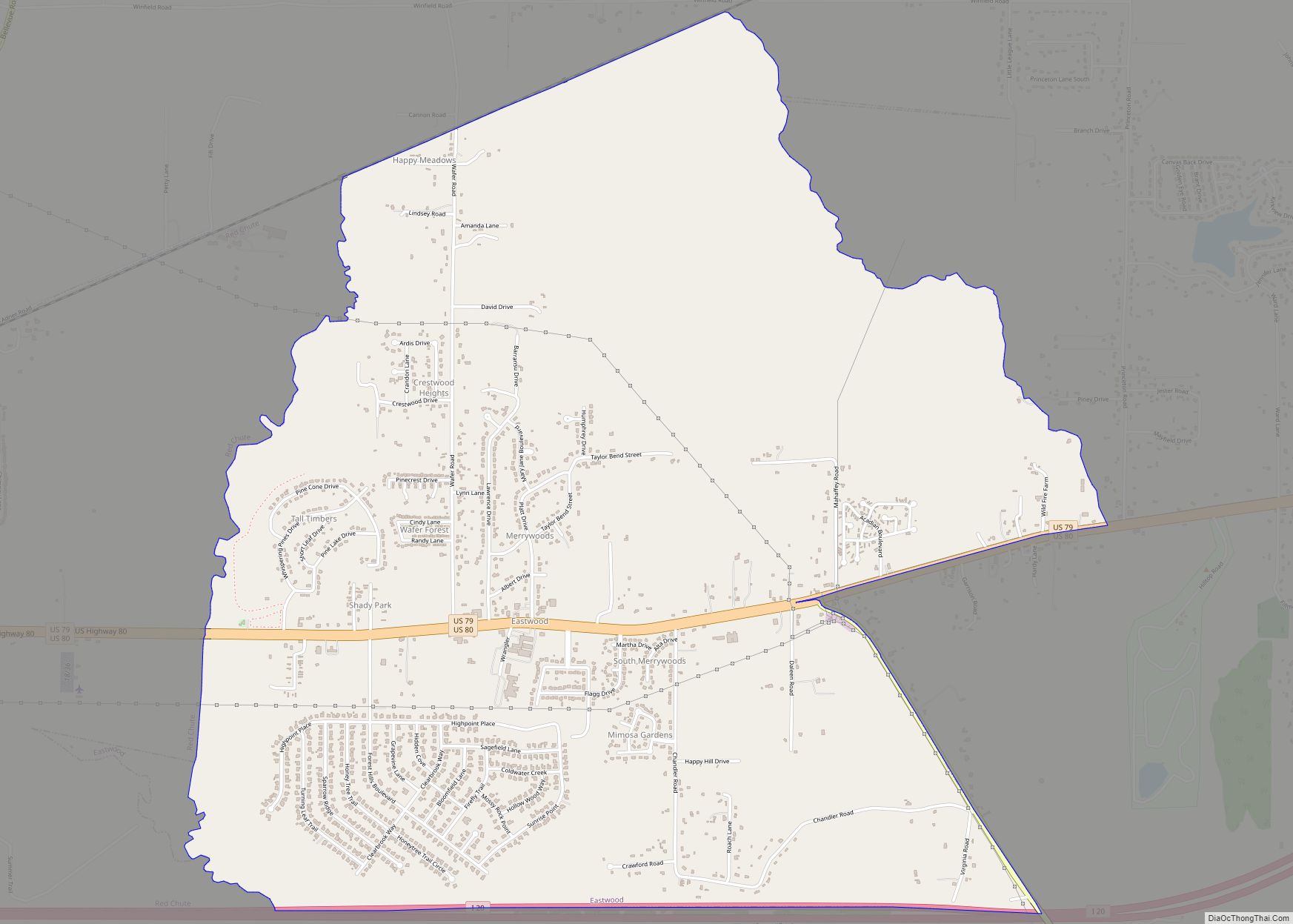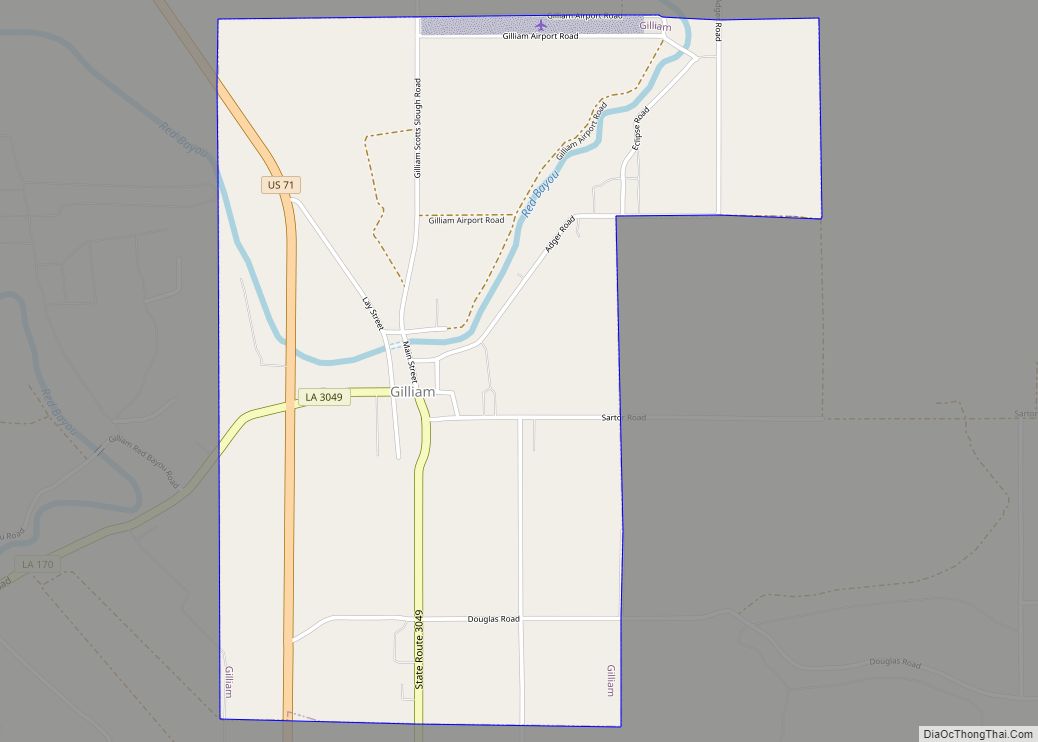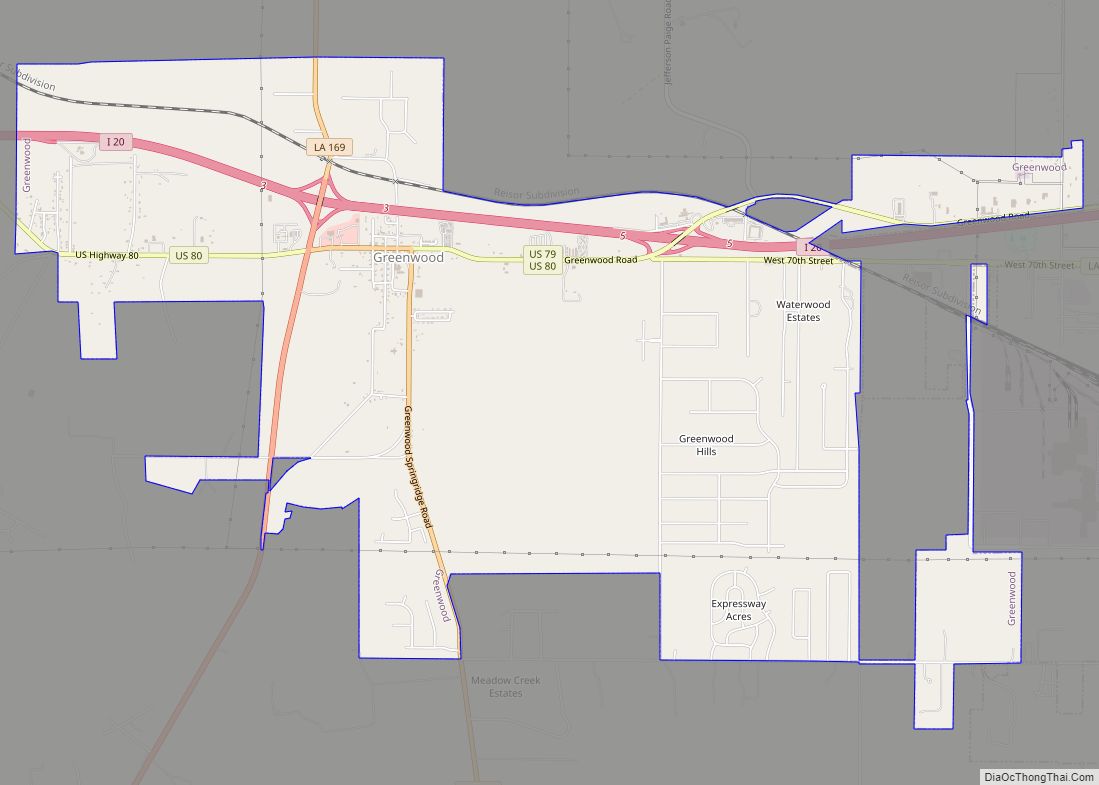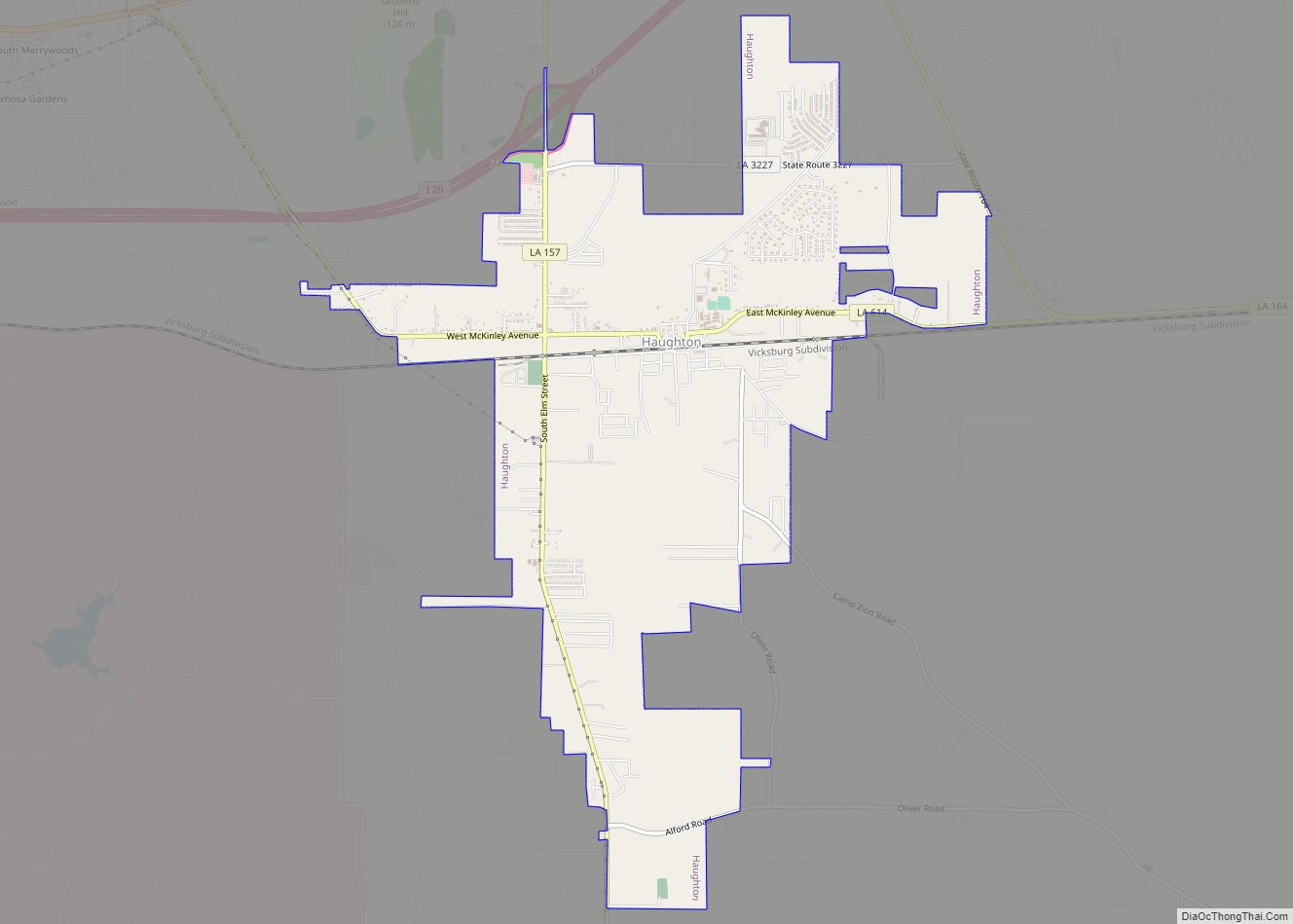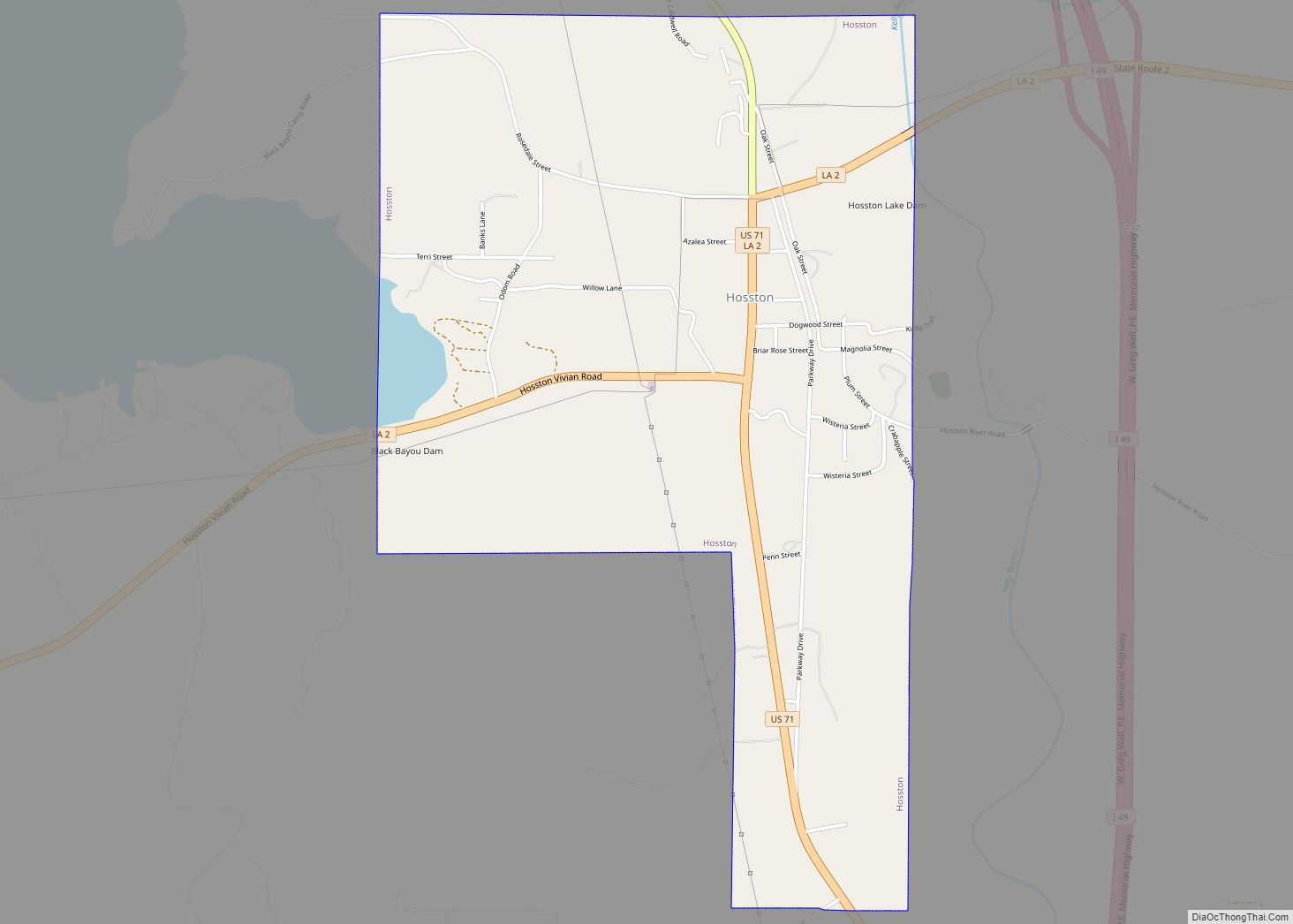Shreveport (/ˈʃriːvpɔːrt/ SHREEV-port) is a city in the U.S. state of Louisiana. It is the third most populous city in Louisiana after New Orleans and Baton Rouge. The Shreveport–Bossier City metropolitan area, with a population of 393,406 in 2020, is the fourth largest in Louisiana, though 2020 census estimates placed its population at 397,590. The bulk of Shreveport is in Caddo Parish, of which it is the parish seat. It extends along the west bank of the Red River (most notably at Wright Island, the Charles and Marie Hamel Memorial Park, and Bagley Island) into neighboring Bossier Parish. The United States Census Bureau’s 2020 census tabulation for the city’s population was 187,593, though the American Community Survey’s census estimates determined 189,890 residents.
Shreveport was founded in 1836 by the Shreve Town Company, a corporation established to develop a town at the juncture of the newly navigable Red River and the Texas Trail, an overland route into the newly independent Republic of Texas. Prior to Texas becoming independent, this trail entered Mexico. It grew throughout the 20th century and, after the discovery of oil in Louisiana, became a national center for the oil industry. Standard Oil of Louisiana (absorbed by Standard Oil of New Jersey and now part of ExxonMobil) and United Gas Corporation (now part of Pennzoil) were headquartered in the city until the 1960s and 1980s. After the loss of jobs in the oil industry, the close of Shreveport Operations (a General Motors vehicle factory), and other economic problems it struggled with a declining population, poverty, drugs and violent crime. However, the city continues in its efforts to revitalize its infrastructure, revive the economy through diversification, and lower crime. Despite these efforts, the city witnessed the largest number of homicides in its recorded history in 2021, eclipsing the previous record set in 1993.
Shreveport is the educational, commercial and cultural center of the Ark-La-Tex region, where Arkansas, Louisiana, and Texas meet. It is the location of Centenary College of Louisiana, Louisiana State University Shreveport, Louisiana Tech University Shreveport, Southern University at Shreveport, and Louisiana Baptist University. Its neighboring city, Bossier City, is the location of Bossier Parish Community College. It forms part of the I-20 Cyber Corridor linking Shreveport, Bossier City, Ruston, Grambling, and Monroe to Dallas and Tyler, Texas, and Atlanta, Georgia. Companies with significant operations or headquarters in Shreveport are Amazon, Regions Financial Corporation, JPMorgan Chase, Sam’s Town Hotel and Gambling Hall, AT&T Mobility, United Parcel Service, Walmart, Chick-fil-A, Waffle House, SWEPCO, General Electric, UOP LLC, Calumet Specialty Products Partners, and APS Payroll.
| Name: | Shreveport city |
|---|---|
| LSAD Code: | 25 |
| LSAD Description: | city (suffix) |
| State: | Louisiana |
| County: | Bossier Parish, Caddo Parish |
| Founded: | 1836 |
| Incorporated: | March 20, 1839 |
| Elevation: | 154 to 253 ft (46 to 77.1 m) |
| Land Area: | 108.14 sq mi (280.10 km²) |
| Water Area: | 15.69 sq mi (40.65 km²) |
| Population Density: | 1,734.64/sq mi (669.75/km²) |
| ZIP code: | 71101-71109, 71115-71166 |
| Area code: | 318 |
| FIPS code: | 2270000 |
| Website: | shreveportla.gov |
Online Interactive Map
Click on ![]() to view map in "full screen" mode.
to view map in "full screen" mode.
Shreveport location map. Where is Shreveport city?
History
Early settlers
Shreveport was established to create a town at the meeting point of the Brown Bricks and the Texas Trail. The Red River was made navigable by Captain Henry Miller Shreve, who led the United States Army Corps of Engineers efforts to clear the Red River. A 180-mile-long (290 km) natural log jam, the Great Raft, had previously obstructed passage to shipping. Shreve used a specially modified riverboat, the Heliopolis, to remove the log jam. The company and the village of Shreve Town were named in Shreve’s honor.
Shreve Town was originally contained within the boundaries of a piece of land sold to the company in 1835 by the indigenous Caddo Indians. In 1838 Caddo Parish was created from the large Natchitoches Parish, and Shreve Town became its parish seat. On March 20, 1839, the town was incorporated as Shreveport. Originally, the town consisted of 64 city blocks, created by eight streets running west from the Red River and eight streets running south from Cross Bayou, one of its tributaries.
Shreveport soon became a center of steamboat commerce, carrying mostly cotton and agricultural crops from the plantations of Caddo Parish. Shreveport also had a slave market, though slave trading was not as widespread as in other parts of the state. Steamboats plied the Red River, and stevedores loaded and unloaded cargo. By 1860, Shreveport had a population of 2,200 free people and 1,300 slaves within the city limits.
Civil War and Reconstruction
During the American Civil War, Shreveport was the capital of Louisiana from 1863 to 1865, having succeeded Baton Rouge and Opelousas after each fell under Union control. The city was a Confederate stronghold throughout the war and was the site of the headquarters of the Trans-Mississippi Department of the Confederate Army. Fort Albert Sidney Johnston was built on a ridge northwest of the city. Because of limited development in that area, the site is relatively undisturbed in the 21st century.
Isolated from events in the east, the Civil War continued in the Trans-Mississippi theater for several weeks after Robert E. Lee’s surrender in April 1865, and the Trans-Mississippi was the last Confederate command to surrender, on May 26, 1865. “The period May 13–21, 1865, was filled with great uncertainly after soldiers learned of the surrenders of Lee and Johnston, the Good Friday assassination of President Abraham Lincoln and the rapid departure of their own generals.” In the confusion there was a breakdown of military discipline and rioting by soldiers. They destroyed buildings containing service records, a loss that later made it difficult for many to gain Confederate pensions from state governments.
The Red River, opened by Shreve in the 1830s, remained navigable throughout the Civil War. But seasonal water levels got so low at one point that Union Admiral David Dixon Porter was trapped with his gunboats north of Alexandria. His engineers quickly constructed a temporary dam to raise the water level and free his fleet.
In 1873, Shreveport lost 759 citizens in an 80-day period to a yellow fever epidemic, with over 400 additional victims eventually succumbing. The total death toll from August through November was approximately 1,200. Five Roman Catholic priests in the city and two religious sisters died while caring for yellow fever victims in the city.
20th century to present
A number of local African American musicians became nationally famous. By the 1910s, Huddie William Ledbetter—also known as “Lead Belly”, a blues singer and guitarist—was performing for Shreveport audiences in St. Paul’s Bottoms, the notable red-light district of Shreveport that operated legally from 1903 to 1917. Ledbetter began to develop his own style of music after exposure to a variety of musical influences on Fannin Street, a row of saloons, brothels, and dance halls in the Bottoms. Bluesmen Jesse Thomas, Dave Alexander, and Kenny Wayne Shepherd, and the early jazz and ragtime composers Bill Wray and Willian Christopher O’Hare were all from Shreveport. Lead Belly achieved international fame.
By 1914, neglect and lack of use, due to diversion of freight traffic to railroad lines, resulted in the Red River becoming unnavigable. In projects accomplished over decades, in 1994, the United States Army Corps of Engineers restored navigability by completion of a series of federally funded lock-and-dam structures and a navigation channel.
As early as 1924, the citizens of Shreveport became interested in hosting a military flying field. In 1926, Shreveport citizens learned that the 3rd Attack Wing stationed at Fort Crockett, Texas, would be enlarged by 500 percent and would require at least 20,000 acres (81 km) to support aerial gunnery and a bombing range. The efforts to procure the government’s commitment to build the facility in the Greater Shreveport metropolitan area were spearheaded by a committee co-chaired by local civic leaders Andrew Querbes and John D. Ewing, beginning in 1927. It took a great deal of correspondence between the interested parties and the original proposal was rejected. However, in February 1928, a young crop duster, an Air Corps captain named Harold Ross Harris, was hired to fly over the local area in order to find a suitable site for the airfield.
Captain Harris selected what he felt was an adequate location for a military airfield. It was a sprawling section of cotton plantation near Bossier City. The site selection committee, representing the wealthiest taxpayers in the city, unanimously agreed upon the Barksdale Field location. A delegation of citizens traveled to Washington, D.C., to personally present the advantages of the proposed site to the War Department. Following the return of this delegation, a special army board visited Shreveport and reported the location met all requirements of the Air Corps.
The site was selected December 5, 1928, as the location of the airfield. The land in Bossier Parish on which the airfield was built was unincorporated land near Bossier City that was annexed by the city of Shreveport once the site had been selected among 80 candidates. The real estate was purchased from over 800 property owners via a $1,500,000 municipal bond issue approved by Shreveport voters in 1929 in fulfillment of the pledge that the citizens of Shreveport made to the U.S. government. The last of these bonds matured on December 31, 1959. After acquisition, Shreveport then donated the land to the federal government per their agreement, while the federal government assumed all the costs of building construction and equipment installation. Shreveport had originally proposed a site adjacent to Cross Lake, but the United States Department of War deemed this location inappropriate due to the lack of suitable terrain for the facility’s future expansion. Subsequent to the establishment of the military installation, Bossier City grew and expanded southward and eastward, eventually enveloping the area surrounding the base. Technically, Barksdale AFB is neither in Bossier City nor Shreveport but, like all military bases, is an autonomous community with its own infrastructure.
In September, 1941, the capture of the city of Shreveport was the objective of a U.S. Army war game, or military exercise, known as the Louisiana Maneuvers. The field exercise’s mission was accomplished largely due to General George S. Patton, who commanded the mock “Blue” army’s 2nd Armored Division.
Shreveport was home to the Louisiana Hayride radio program, broadcast weekly from the Shreveport Municipal Memorial Auditorium. During its heyday from 1948 to 1960, this program stimulated the careers of some of the greatest figures in American music. The Hayride featured musicians including Hank Williams and Elvis Presley, who made his broadcasting debut at this venue. In the mid-1950s, KWKH was the first major radio station to feature the music of Presley on its long-running Louisiana Hayride program at the Shreveport Municipal Auditorium. Horace Logan, long-term KWKH program manager and originator of the Hayride, and Frank Page introduced Presley on the Hayride.
African American veterans of World War II were among activists in Shreveport through the 1960s who worked in the civil rights movement to correct injustices under Jim Crow and disenfranchisement of blacks. While activism gradually increased, 1963 was a particularly violent year in Shreveport because of white resistance. The Shreveport home of Dr. C. O. Simpkins was bombed in retaliation for his work with Dr. Martin Luther King Jr.
In September 1963 George W. D’Artois, Public Service Commissioner, refused a permit for a march to the Little Union Baptist Church in Shreveport, where mourners gathered to honor and commemorate four black girls killed in the 16th Street Baptist Church Bombing on September 15 in Birmingham, Alabama. D’Artois and other officers entered the church on horseback and took out the pastor, Dr. Harry Blake, beating him severely.
Also in 1963, headlines across the country reported that African American musician Sam Cooke was arrested in Shreveport after his band tried to register at a “whites-only” Holiday Inn, where they planned to stay before performing in the city. Public facilities in Louisiana were still segregated. In the months following, Cooke recorded the civil rights era song, “A Change Is Gonna Come”. In 1964 Congress passed the Civil Rights Act to end segregation of public facilities.
In the mid-1990s, the coming of riverboat gambling to Shreveport attracted numerous new patrons to the downtown and spurred a revitalization of the adjacent riverfront areas. Many downtown streets were given a facelift through the “Streetscape” project. Traditional brick sidewalks and crosswalks were built, and statues, sculptures, and mosaics were added to create a better pedestrian environment. The O.K. Allen Bridge, commonly known as the Texas Street bridge, was lit with neon lights. Residents predictably had a variety of reactions to these changes. Shreveport was named an All-American City in 1953, 1979, and 1999.
During the September 11, 2001 attacks, President George W. Bush was taken to the nearby Barksdale Air Force Base. He also made a visit to speak in the city on March 11, 2005.
Since the downturn in the oil industry and other economic problems, the city has struggled with a declining population, unemployment, poverty, drugs and violent crime. City data from 2017 showed a dramatic increase in certain violent crimes from the previous year, including a 138 percent increase in homicides, a 21 percent increase in forcible rapes and more than 130 percent increases in both business armed robberies and business burglaries. In 2018 the local government and police authorities reported a crime drop in most categories; it was part of an overall reduction in crime since the late 20th century. As Shreveport continued its economic resurgence, the Adrian Perkins administration saw the coming of Advanced Aero Services, Tomakk Glass Partners, and the revitalization plan of the Shreveport Economic Recovery Task Force after the Cross Bayou redevelopment plan was rejected.
In June 2020, rapper Hurricane Chris was arrested in Shreveport for second-degree murder. Following the George Floyd killing in Minnesota, multiple protests were held in the city.
Shreveport Road Map
Shreveport city Satellite Map
Geography
Shreveport is located in Northwest Louisiana. It is the center of the Ark-La-Tex region where Arkansas, Louisiana, and Texas meet. It is also part of the I-20 Cyber Corridor linking the tech-centered Dallas–Fort Worth, Shreveport–Bossier, Greater Monroe, and Greater Atlanta metropolitan areas together. The city of Shreveport is 188 miles (303 km) from Dallas, 98 miles (158 km) from Tyler, and 41 miles (66 km) from Marshall, Texas; 215 miles (346 km) from Little Rock and 73 miles (117 km) from Texarkana, Arkansas; and 250 miles (400 km) from the state capital of Baton Rouge, 99 miles (159 km) from Monroe, 69 miles (111 km) from Ruston, and 30 miles (48 km) from Minden, Louisiana. The city’s proximity to the nearby cities makes it North Louisiana and the Ark-La-Tex’s transportation hub.
Shreveport is the parish seat of Caddo Parish. Portions of the city extend into neighboring Bossier Parish, bordering Bossier City. Shreveport sits on a low elevation overlooking the Red River. Western and northern portions of Shreveport have an elevation over 253 feet (77 m) above sea level. Pine forests, cotton fields, wetlands, and waterways mark the outskirts of the city. According to the United States Census Bureau in 2010, the city had a total area of 122.35 sq mi (316.88 km), of which 107.14 sq mi (277.48 km) is land and 15.21 sq mi (39.40 km) is water.
Cityscape
Shreveport—since the mid-1990s—has been a major gambling center with a modest downtown skyline. The “Streetscape” project, inspired by the coming of riverboat gaming, gave Shreveport’s downtown traditional brick sidewalks, statues, sculptures, and mosaics. The O.K. Allen Bridge (Texas Street bridge) was lit with neon lights. Since then, Downtown Shreveport has seen minor changes until the 2010s; the whole of Shreveport has been improving roads since the mid-2010s, with continued road projects in 2018. In 2018, buildings in Shreveport’s downtown and nearby districts were revitalized due to re-investment in the area. In 2020, plans were unveiled for the I-49 Connector and further redevelopment of the city.
Shreveport encompasses many areas, neighborhoods, and districts. The busiest thoroughfares and areas of Shreveport are the Youree Drive area (named for Peter Youree), the Shreveport Downtown Riverfront, and Highland neighborhood. All of the busiest areas are located in Eastern Shreveport, nearby or along the Red River. Below is a list of areas in the Shreveport area of Caddo Parish:
- Acadiana Place
- Allendale
- Allendale-Lakeside, interloop of neighborhoods
- Anderson Island
- Azalea Gardens
- Braemar Estates
- Broadmoor
- Broadmoor Terrace
- Brunswick Place
- Caddo Heights
- Cedar Grove
- Chapel Creek
- Cherokee Park
- Cooper Road
- Crescent Wood
- Cross Lake, some not in city
- Dixie Gardens
- Eden Gardens
- Ellerbe Road Estates
- Ellerbe Woods
- Evangeline Oaks
- Fairfield Heights
- Forbing
- Fox Crossing
- Garden Valley
- Glen Iris
- Greenbrook
- The Haven
- Hidden Trace
- Highland
- Hollywood
- Hollywood Heights
- Huntington
- Ingleside
- Jackson Square
- Jewella-South Park
- Hyde Park
- Lakeside
- Lakeside Acres
- Lakeside on Long Lake
- Ledbetter Heights or The Bottoms
- Long Lake Estates
- Lynbrook
- Madison Park
- Mooretown
- Norris Ferry Crossing
- Norris Ferry Estates
- Norris Ferry Landing
- North Highlands
- Parkside
- Pines Road
- Pierremont
- Pierremont Place
- Pierremont Ridge
- Provenance
- Queensborough
- St. Charles Place
- Shreve Island
- Shreve Lake Estates
- South Broadmoor
- South Highlands
- Southern Hills
- Southern Trace
- Spring Lake
- Stoner Hill
- Sunset Acres
- Towne South
- Twelve Oaks
- Shadow Pines Estates
- Steeple Chase
- Stoner Hill
- University Terrace
- Waterside
- West End
- Western Hills
- Wright Island
- Yarborough
Robinson Place in Shreveport, former home of physician and developer George W. Robinson; later the residence of Douglas and Lucille Lee, owners of Lee Hardware Company
Historic residence of late Louisiana Lieutenant Governor Thomas Charles Barret at Fairfield and Prospect
Walker House on Fairfield Avenue was once the home of the Coca-Cola bottler Zehntner Biedenharn.
Bliss-Hoyer House, built by Abel and Nettie Bliss, was later the home of Ewald Max Hoyer, the first mayor of Bossier City, who continued to reside in Shreveport.
Climate
Shreveport has a humid subtropical climate (Köppen climate classification Cfa). Rainfall is abundant, with the normal annual precipitation averaging over 51 inches (1,300 mm), with monthly averages ranging from less than 3 inches (76 mm) in August to more than 5 inches (130 mm) in June. Severe thunderstorms with heavy rain, hail, damaging winds and tornadoes occur in the area during the spring and summer months. The winter months are normally mild, with an average of 35 days of freezing or below-freezing temperatures per year, with ice and sleet storms possible.
Summer months are hot and humid, with maximum temperatures exceeding 90 °F (32 °C) on an average of 91 days per year, with high to very high relative average humidity. The extreme temperatures range from −5 °F (−21 °C) on February 12, 1899, to 110 °F (43 °C) on August 18, 1909. Shreveport is home to a branch of the National Weather Service which provides forecasts and warnings for the greater Ark-La-Tex region.
See also
Map of Louisiana State and its subdivision:- Acadia
- Allen
- Ascension
- Assumption
- Avoyelles
- Beauregard
- Bienville
- Bossier
- Caddo
- Calcasieu
- Caldwell
- Cameron
- Catahoula
- Claiborne
- Concordia
- De Soto
- East Baton Rouge
- East Carroll
- East Feliciana
- Evangeline
- Franklin
- Grant
- Iberia
- Iberville
- Jackson
- Jefferson
- Jefferson Davis
- La Salle
- Lafayette
- Lafourche
- Lincoln
- Livingston
- Madison
- Morehouse
- Natchitoches
- Orleans
- Ouachita
- Plaquemines
- Pointe Coupee
- Rapides
- Red River
- Richland
- Sabine
- Saint Bernard
- Saint Charles
- Saint Helena
- Saint James
- Saint John the Baptist
- Saint Landry
- Saint Martin
- Saint Mary
- Saint Tammany
- Tangipahoa
- Tensas
- Terrebonne
- Union
- Vermilion
- Vernon
- Washington
- Webster
- West Baton Rouge
- West Carroll
- West Feliciana
- Winn
- Alabama
- Alaska
- Arizona
- Arkansas
- California
- Colorado
- Connecticut
- Delaware
- District of Columbia
- Florida
- Georgia
- Hawaii
- Idaho
- Illinois
- Indiana
- Iowa
- Kansas
- Kentucky
- Louisiana
- Maine
- Maryland
- Massachusetts
- Michigan
- Minnesota
- Mississippi
- Missouri
- Montana
- Nebraska
- Nevada
- New Hampshire
- New Jersey
- New Mexico
- New York
- North Carolina
- North Dakota
- Ohio
- Oklahoma
- Oregon
- Pennsylvania
- Rhode Island
- South Carolina
- South Dakota
- Tennessee
- Texas
- Utah
- Vermont
- Virginia
- Washington
- West Virginia
- Wisconsin
- Wyoming
